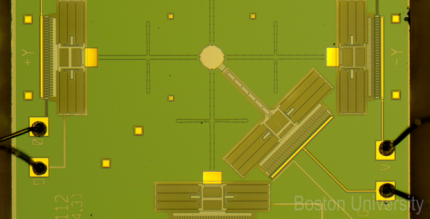DARPA picks 10 to build nano-based products
Ten companies and university partners will split into three working groups to assemble atoms into working devices.

Tools such as Boston University’s nanoscale “atom writer” fabricate minuscule light-manipulating structures on surfaces.
Ten research organizations have been tapped by the Defense Advanced Research Projects Agency to develop technologies and processes for assembling nano-scale building blocks for materials and millimeter-scale components.
DARPA announced the awards at the end of December under its "Atoms to Products" (A2P) initiative designed to leverage unique "atomic-scale" characteristics like much lower melting points and greater heat resistance.
Academic contractors include Boston University, Harvard University, MIT's Draper Laboratories and the University of Notre Dame. Private sector developers include Embody, HRL Laboratories, Palo Alto Research Center (formerly Xerox PARC), SRI International, Voxtel Inc. and Zyvex Labs.
DARPA said the 10 developers would divide into three working groups.
Embody, Draper Labs and Voxtel will collaborate on an effort called "Nanometer to Millimeter in a Single System." Among the planned projects are developing sub-micron wires that can be braided to make radio-frequency systems more power-efficient while transmitting 10 times more information on a single channel.
Boston University, Notre Dame, HRL and PARC form a working group on optical meta-material assembly. One initiative calls for Boston University researchers to develop a technique to "spray paint" atoms with nano-scale precision to build tunable optical meta-materials for the "photonic battlefield."
HRL Laboratories, a corporate R&D lab jointly owned by Boeing and General Motors, said last fall it was developing processes under the A2P program to assemble nano-scale materials into millimeter-scale components that are compatible with existing manufacturing technologies. It is working with Intelligent Materials Solutions Inc. of Princeton, N.J., to assemble nano-scale particles used to create finished components that would be 1 million times larger than individual nano-scale particles.
A "flexible, general purpose assembly" working group that includes Harvard SRI and Zyvex will among other things focus on developing micron-scale devices that include electronic, optical and nano-mechanical components. DARPA said resulting devices could be used in subsystems like extremely sensitive sensors, quantum communications and atomic clocks the size of a grain of sand.
“The ability to assemble atomic-scale pieces into practical components and products is the key to unlocking the full potential of micro-machines,” John Main, DARPA program manager, noted in a statement announcing the A2P contractors.
NEXT STORY: Navy wants small drones that can see in the dark




